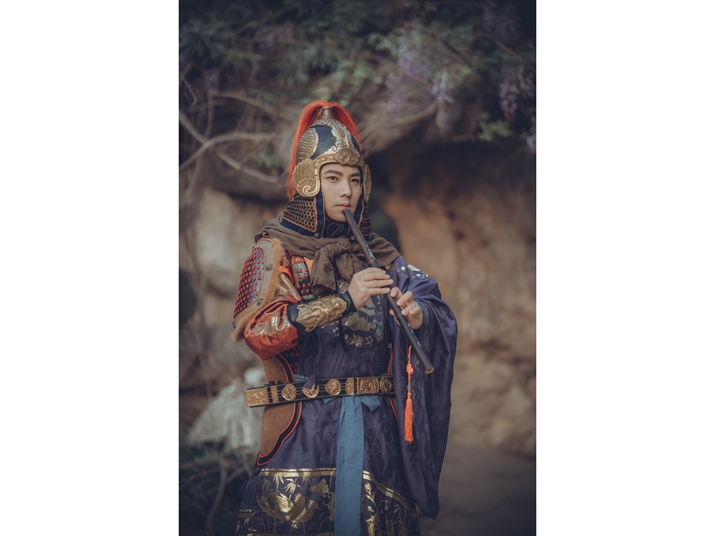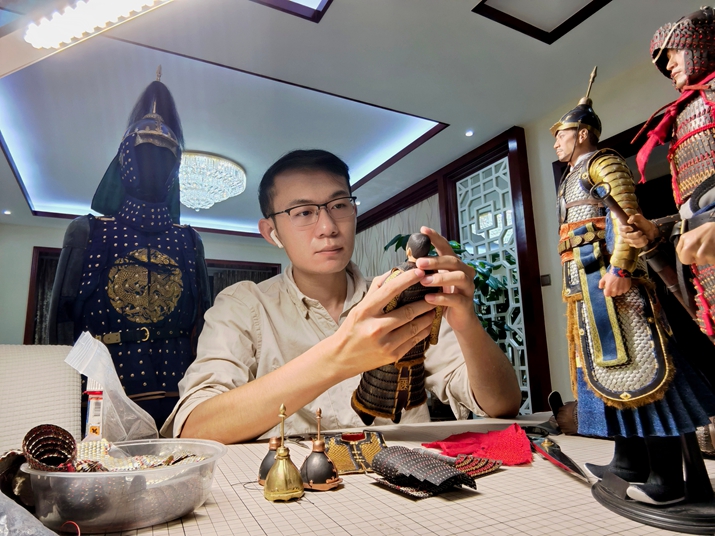| Lifestyle |
| Fierce and fashionable, fans of Chinese armor plunge deep into the archives | |
|
|
 Zhou Yu in Ming Dynasty (1368-1644) armor at the Beijing Garden Expo Park in June (COURTESY PHOTO)
Buried deep in the ruins of the Shang Dynasty (about 1600-1046 B.C.), more specifically in Anyang City of Henan Province, bones of the rhino were found. A collection of archaeological evidence and references in ancient Chinese literature has verified the existence of the rhinoceros in ancient China. The animal was scattered across China's Central Plains, where the Yellow River passes through and Chinese civilization originated. Nevertheless, the rhino was no longer roaming the region after the Han Dynasty (202 B.C.-A.D. 220). Some scientists think it was the colder climate of Northeast Asia that saw the creature fade from the pages of history. Zhou Yu, a writer with National Humanity History, a Beijing-based Chinese semi-monthly magazine, offered up another explanation: the crafting of armor. Zhou's book, The History of Chinese Armor, reads that the rhino's thick skin was a primary material for the creation of warriors' armor. Many ancient accounts recorded the killing of rhinos and turning their skin into protective covering. "The huge demand for rhino skins might have propelled the animal's disappearance or at least its migration from the Central Plains to the southwestern regions," Zhou told Beijing Review. Armor was originally made of bamboo and rattan, but these materials possessed limited defensive capabilities. Leather armor later became the ruling trend during the pre-Qin period (about 2100-221 B.C.). "It's hard to preserve leather products, so we don't fully or accurately know what these protective suits looked like and can only derive their original appearance from the historical literature and some leftover fragments," Zhou said. Additionally, bronze was another important material used during the period, the book further states, but mainly used for helmets and not for body armor due to technological reasons. Iron armor also appeared at the time, but rarely so, the book reads. According to Zhou, as technology developed and requirements evolved, China's warrior armor was undergoing changes and improvements, including its bespoke ceremonial versions designed for imperial audiences and court activities. Brothers in armor When the age of sword battle came to an end, the ancient armor made a temporary exit from the annals of history, but once again resurrected, not just through the efforts of historians and archaeologists, but through modern-day young adults like Zhou. Zhou's passion for armor stretches well beyond the realm of literature: He wears it, he breathes it and, like many of his friends, he collects and assembles military figurines. Many readers may have already heard of hanfu, or traditional Chinese costume, gatherings. The body armor troupe is a subgenre thereof. Wearing his suit of ancient armor to hanfu activities, Zhou met many other aficionados, together with whom he later established a new society in Beijing. "One day, when I wore my armor and was taking pictures at the Great Wall, another guy decked out in similar ancient protective gear came to have a pretend fight with me. We kept in touch and ended up becoming good friends," Zhou said. As their group has grown bigger, these armor aficionados will periodically organize activities. For example, putting on their full armor and venturing out to take some photographs at historical sites. Sometimes, they even act out famous historical battle scenes on camera. Zhou and several others rent a warehouse in the suburbs of Beijing to store their stuff. Their armors are expensive and take up much room, but by storing them all together, they can also share everything with one another. In addition to wearing 1:1 (full body) armor clothing, collecting 1:6 military figurines is another popular hobby. Zhou has amassed hundreds of these collectibles, altogether nearly taking up an entire room. Zhou's friend Li Xiang, an armor fan who lives in Shanghai, prefers to purchase the different components of these statuettes and assemble them with his own hands. "Every year, I spend some 30,000 yuan ($4,650) on armor attire and military figurines," Li told Beijing Review. According to Li, he first started creating small and simple suits of armor when he was very young. "I was attracted by the ancient warrior costumes I would see in costume dramas and would first use cardboard to make my own versions." He Li, a 25-year-old who works for a state-owned company in Yunnan Province's capital of Kunming, produces 1:6 military figures which he began selling on Xianyu, an online consumer-to-consumer marketplace, in 2019. "I originally began collecting the military statuettes of modern war movies in high school, and then in 2019 I watched an armor-themed video on Bilibili, one of China's most prevalent short-video platforms, and just found it to be incredibly cool," He told Beijing Review. He then began to try and assemble 1:6 military figures decked out in ancient protective gear and put them up for sale online. Usually, it takes him one or two weeks to put together a full one. "I do this after work and use the profits to buy new components and 1:1 armor clothing," He said. By now, he has sold over 70 items. A 1:1 armor clothing item usually retails around 30,000 yuan; a 1:6 military figure goes for 3,000 to 8,000 yuan ($464-1,240).  He Li crafts 1:6 military figurines at home in Kunming, capital of Yunnan Province, on September 13 (COURTESY PHOTO)
Witnessing history "Yes, I love body armor and am eager to learn everything about it," Zhou explained. "But I am more than just an armor aficionado; I prefer to define myself as a history devotee, and armor as a vehicle to plunge deep into the past." The Qin Dynasty (221–206 B.C.) revered the color black, but did they actually don black armor? The answer here is no. The Terracotta Warriors, a clay Qin army of more than 8,000 life-sized soldiers and horses discovered in 1974 in Xi'an, Shaanxi Province, presents a wider color palette. Did the Qin warriors have a standard battle uniform? In a letter to his family, one soldier named Heifu asks his mother to send him some summer clothes or money to buy clothes. "From this letter, we derived that the Qin warriors were probably responsible for creating their own military gear," Zhou speculated in the book. In recent years, the Chinese entertainment industry has seen many costume dramas, as well as many online games, with their stories set in ancient China. Unfortunately, some of those works didn't get things quite right. "Actually, those TV series have improved in terms of the daily clothing they present, but their staging of body armors still does not meet the actual historical background," He said. For example, in some films and games, the armors were adopted from the Japanese and European chronicles, not the Chinese. "I hope that, in the future, cultural products can convey the real face of Chinese armor," He continued. When crafting his military collectibles, He studies many historical works plus materials, for example, ancient murals. However, does the literature of ancient times always paint a truthful image? No, Zhou replied. Romance of the Three Kingdoms is a Chinese epic novel about the century of war, turmoil and regime change known as the Three Kingdoms Period (220-280), written in the Ming Dynasty (1368-1644). Consequently, many illustrated books produced during this era were in fact based on this particular novel. "An interesting thing here is that these picture books actually showcase Ming armor, not that of the Three Kingdoms Period," Zhou said. The more they focus on China's ancient body armor, the deeper Zhou, He and their friends dig into its ancient archives. "Armor is a part of our history and I want people to know the real story behind the shield," Zhou concluded. (Print Edition title: Armed With History) Copyedited by Elsbeth van Paridon Comments to taoxing@bjreview.com |
|
||||||||||||||||||||||||||||||
|